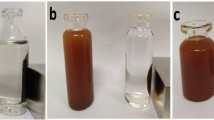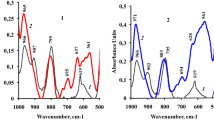Abstract
In modern methods of synthesis of nanostructured materials based on mesoporous silica matrices (MCM-41, SBA-15), it is not possible to simultaneously fine adjust both the pore diameter and the thickness of the separating walls. This article presents the results of work on the creation of composites based on mesoporous silica matrices MCM-41 and SBA-15, reinforced with metallic Fe nanoparticles (Fe NPs). The article considers a new way of ultrafine regulation of the pore radius and separating wall thickness mesoporous silica SBA-15. In this work, we studied the changes in their structural and magnetic characteristics by directionally adjusting the geometric parameters of the porous structure of the initial matrices. The following methods are applied to adjust the silica pore parameters: hydrothermal treatment and templating using a micellar expander. The technique is based on building up aluminum-oxygen nanolayers on the pore walls using gas-phase atomic layer deposition technique (ALD). Studying room-temperature magnetization of Fe NPs obtained during the synthesis in a matrix of mesoporous silica MCM-41 (pore size of 3–5 nm) allowed us to establish superparamagnetic properties of such magnetic materials, which allows to use them in medicine for targeted drug delivery. Fe NPs in the mesoporous silica SBA-15 matrix with a pore size of 3–6 nm also exhibit superparamagnetic properties, and these composites showed a coercive force increase with an increase in the original matrix pore size.















Similar content being viewed by others
References
Arbenin AY, Zemtsova EG, Smirnov VM (2012) Regulation of the geometric parameters of mesoporous silica SBA-15 using the method of molecular layering and investigation of their porous structure. Nanotechnologies in Russia 7(3–4):117–121
Barreca D, Blau WJ, Croke GM, Deeney FA, Dillon FC, Holmes JD, Kufazvinei C, Morris MA, Spalding TR, Tondello E (2007) Iron oxide nanoparticle impregnated mesoporous silicas as platforms for the growth of carbon nanotubes. Microporous Mesoporous Mater 103(1–3):142–149
Butter K, Philipse AP, Vroege GJ (2002) Synthesis and properties of iron ferrofluids. J Magn Magn Mater 252:1
Cao L, Man T, Kruk M (2009) Synthesis of ultra-large-pore SBA-15 silica with two-dimensional hexagonal structure using triisopropylbenzene as micelle expander. Chem Mater 21(6):1144–1153
Ermakova LE, Sidorova MP, Smirnov VM (1997) Isoelectric point of silicon oxide particles coated by monolayers of oxides of titanium and aluminum. Kolloidnyj Zhurnal 59(4):563–565
Gaffer A, Al Kahlawy AA, Aman D (2017) Magnetic zeolite-natural polymer composite for adsorption of chromium (VI). Egypt J Pet 26(4):995–999
Gaihre B, Khil MS, Lee DR, Kim HY (2009) Gelatin-coated magnetic iron oxide nanoparticles as carrier system: drug loading and in vitro drug release study. Int J Pharm 365(1–2):180–189
George SM (2010) Atomic layer deposition: an overview. Chem Rev 110:111–131
Huang X, Dong W, Wang G, Yang M, Tan L, Feng Y, Zhang X (2011) Synthesis of confined Ag nanowires within mesoporous silica via double solvent technique and their catalytic properties. J Colloid Interface Sci 359(1):40–46
Huber DL, Venturini EL, Martin JE, Provencio PP, Patel RJ (2004) Synthesis of highly magnetic iron nanoparticles suitable for field structuring using a β-diketone surfactant. J Magn Magn Mater 278(3):311–316
Huczko A (2000) Template-based synthesis of nanomaterials. Appl Phys A Mater Sci Process 70(4):365–376
Keene MTJ, Denoyel R, Llewellyn PL (1998) Ozone treatment for the removal of surfactant to form MCM-41 type materials. Chem Commun 20:2203–2204
Kruk M, Cao L (2007) Pore size tailoring in large-pore SBA-15 silica synthesized in the presence of hexane. Langmuir 23(13):7247–7254
Liu B, Zhang Z (2015) Catalytic conversion of biomass into chemicals and fuels over magnetic catalysts. ACS Catal 6(1):326–338. https://doi.org/10.1021/acscatal.5b02094
Lu A, Salabas L, Schüth F (2007) Magnetic nanoparticles: synthesis, protection, functionalization, and application. Angew Chem Int Ed 46:1222–1244
Malygin AA, Drozd VE, Malkov AA, Smirnov VM (2015) From V. B. Aleskovskii’s “Framework” hypothesis to the method of molecular layering (an overview). Atomic Layer Deposition 21:216–240
Nazarov DV, Zemtsova EG, Valiev RZ, Smirnov VM (2015) Formation of micro- and nanostructures on the nanotitanium surface by chemical etching and deposition of titania films by atomic layer deposition (ALD). Materials 8(12):8366–8377
Nazarov DV, Maximov MY, Novikov PA, Popovich AA, Silin AO, Smirnov VM, Bobrysheva NP, Osmolovskaya OM, Osmolovsky MG, Rumyantsev AM (2017) Atomic layer deposition of tin oxide using tetraethyltin to produce high-capacity Li-ion batteries. Journal of Vacuum Science and Technology A: Vacuum, Surfaces and Films 35(1):01B137
Osmolowskaya OM, Smirnov VM (2011) Growth mechanism of nanodimensional vanadium dioxide on silicon surface obtained by ML-ALD method. Rev Adv Mater Sci 27(2):184–188
Shevtsov M. A., Parr M. A., Ryzhov V. A., Zemtsova E. G., Arbenin A. Y., Ponomareva A. N., Multhoff, G. (2016). Zero-valent Fe confined mesoporous silica nanocarriers (Fe(0) @ MCM-41) for targeting experimental orthotopic glioma in rats. Sci Rep, 6(1)
Smirnov VM (2002) Nanoscaled structuring as a way to constructing new solid substances and materials. Russ J Gen Chem 72(4):590
Smirnov VM, Povarov VG, Voronkov GP, Semenov VG, Murin IV, Gittsovich VN, Sinel'nikov BM (2001) Solid-state water-mediated transport reduction of nanostructured iron oxides. J Nanopart Res 3:83–89
Smirnov VM, Zemtsova EG, Ivanov EB, Osmolowsky MG, Semenov VG, Murin IV (2002) Mössbauer and magneto-chemical study of solids formed by surface chemical reaction of OH-silica groups with iron diacetylacetonato chloride (C5H7O2)2FeCl. Appl Surf Sci 195:1–4 89-92
Smirnov VM, Zemtsova EG, Morozov PE (2009) Forced organization of magnetic quasi-one-dimensional iron-organic nanostructures on inorganic matrices. Rev Adv Mater Sci 21(2):205–210
Tretyakov Yu D, Lukashin A.V., Eliseev A. A. Synthesis of functional nanocomposites based on solid-phase nanoreactors. Uspekhi khimii 2004. 73, 9, 974–998
Tüysüz H, Lehmann CW, Bongard H, Tesche B, Schmidt R, Schüth F (2008) Direct imaging of surface topology and pore system of ordered mesoporous silica (MCM-41, SBA-15, and KIT-6) and nanocast metal oxides by high resolution scanning electron microscopy. J Am Chem Soc 130(34):11510–11517
Vonsovskii SV (1974) Magnetism. J. Wiley, New York
Wang Q, Kanel SR, Park H, Ryu A, Choi H (2008) Controllable synthesis, characterization, and magnetic properties of nanoscale zerovalent iron with specific high Brunauer–Emmett–Teller surface area. J Nanopart Res 11(3):749–755
Yoon M, Kim YM, Kim Y, Volkov V, Song HJ, Park YJ, Vasilyak SL, Park I-W (2003) Magnetic properties of iron nanoparticles in a polymer film. J Magn Magn Mater 265(3):357–362
Zemtsova EG, Arbenin AY, Plotnikov AF, Smirnov VM (2015) Pore radius fine tuning of a silica matrix (MCM-41) based on the synthesis of alumina nanolayers with different thicknesses by atomic layer deposition. J Vac Sci Technol A 33(2):021519
Zhao G, Liu YJ, Zhou Q, Zhang NZ, Zhu X (2014) Zero-valent iron (Fe(0)) mediated RAFT miniemulsion polymerization: a facile approach for the fabrication of Fe(0)-encapsulated polymeric nanoparticles. Polym Chem 5(14):4215
Zhu W, Han YL, An L (2005) Silver nanoparticles synthesized from mesoporous Ag/SBA-15 composites. Microporous Mesoporous Mater 80(1–3):221–226
Acknowledgments
We acknowledge the Research parks of St. Petersburg State University, the Center for Optical and Laser Research, and the Center for Innovative Technologies of Composite Nanomaterials.
Funding
The work is financially supported by the Russian Science Foundation (Grant 17-03-01331).
Author information
Authors and Affiliations
Corresponding author
Ethics declarations
Conflict of interest
The authors declare that they have no conflict of interest.
Additional information
Publisher’s note
Springer Nature remains neutral with regard to jurisdictional claims in published maps and institutional affiliations.
Rights and permissions
About this article
Cite this article
Zemtsova, E.G., Arbenin, A.Y., Galiullina, L.F. et al. Regulation of the size of metal iron nanoparticles in channels of mesoporous silica matrices (MCM-41, SBA-15) and structure and magnetic properties of the received nanocomposites МСМ-41/Fe0 and SBA-15/Fe0. J Nanopart Res 22, 255 (2020). https://doi.org/10.1007/s11051-020-04960-1
Received:
Accepted:
Published:
DOI: https://doi.org/10.1007/s11051-020-04960-1




